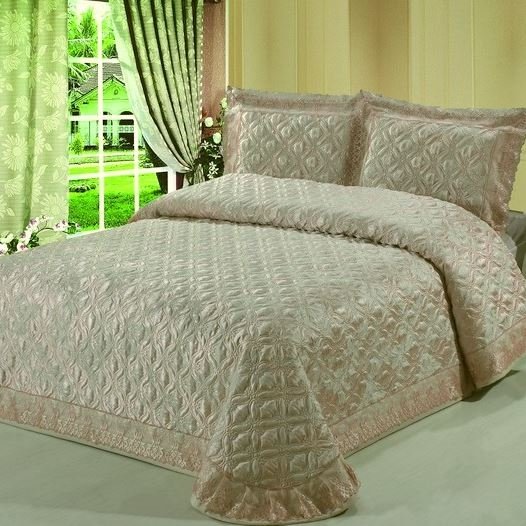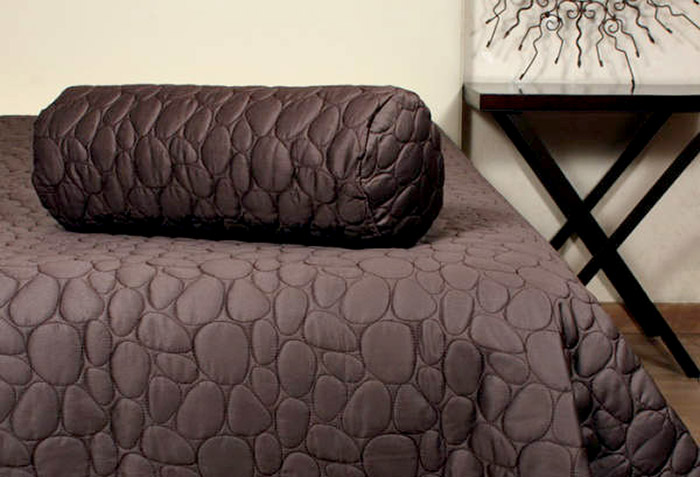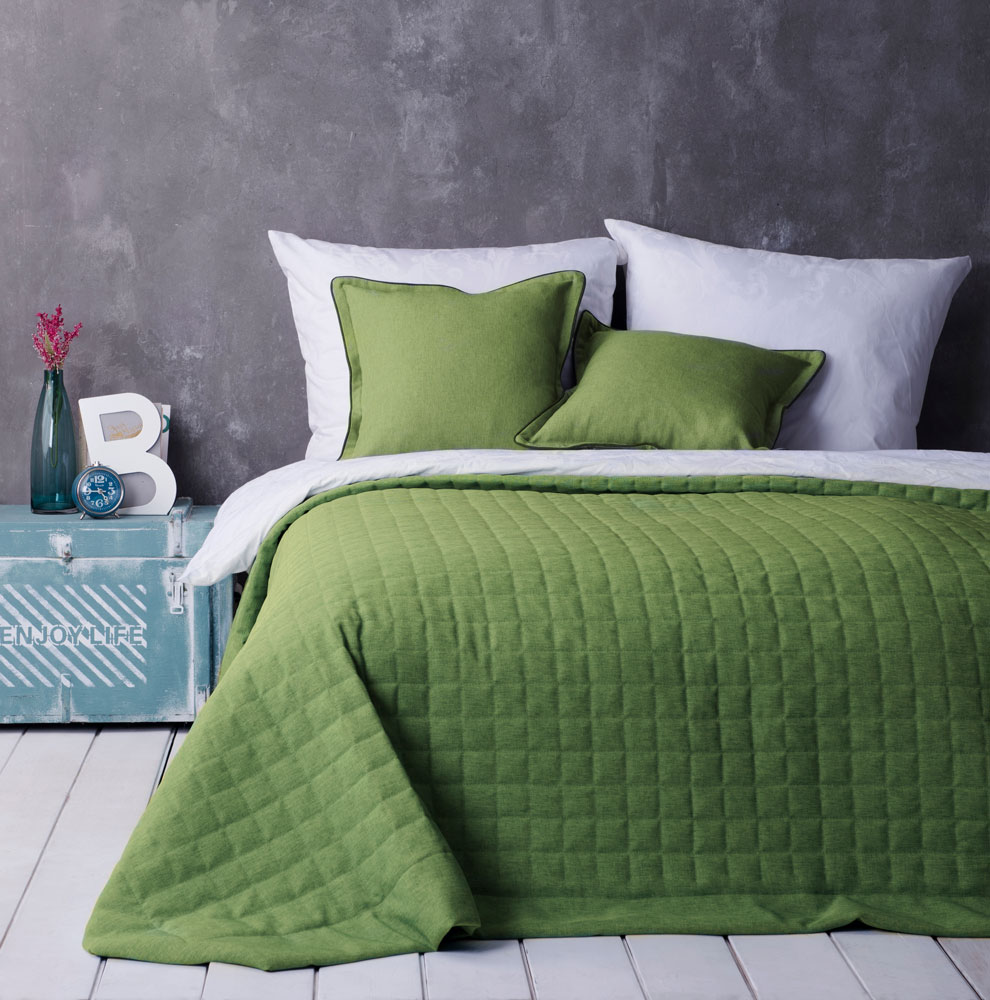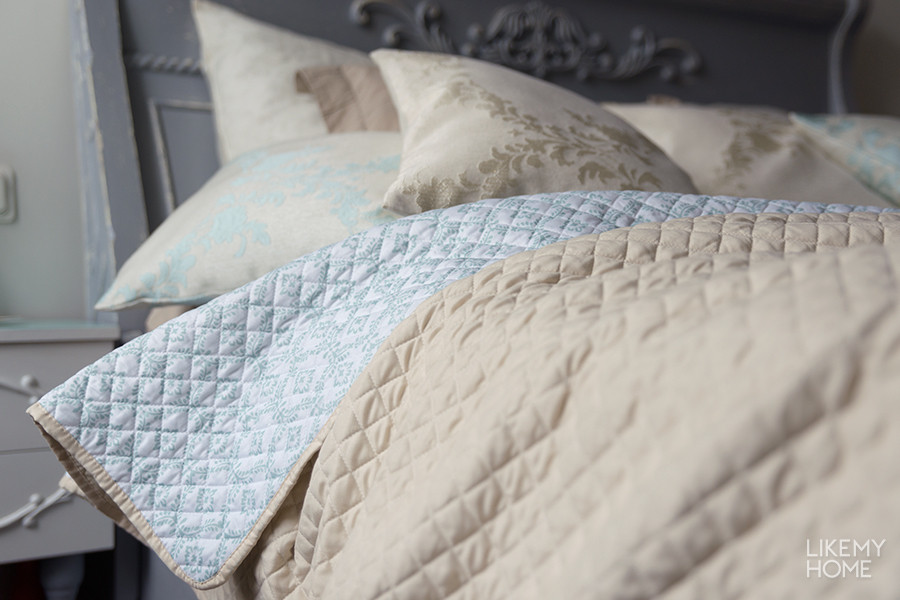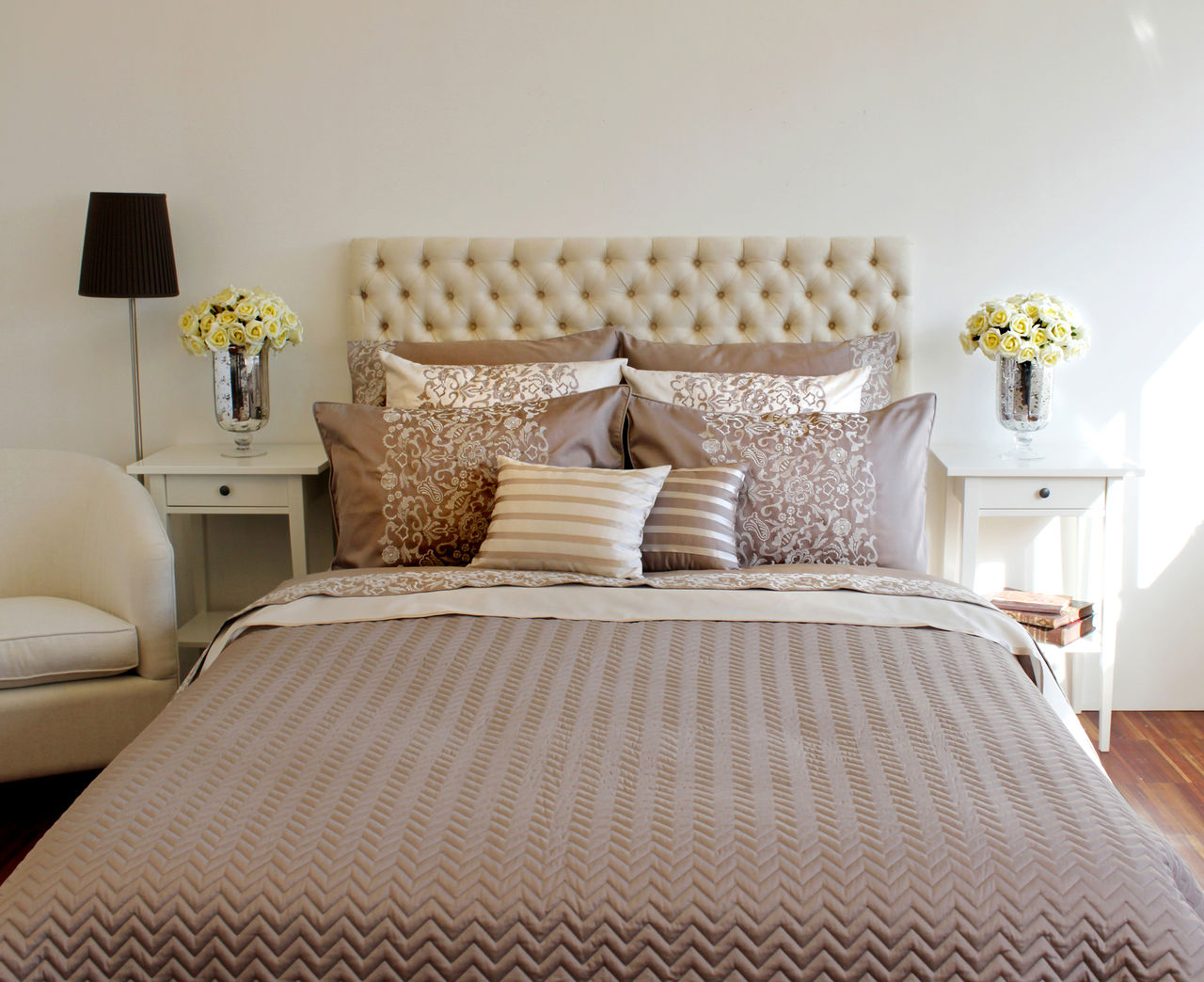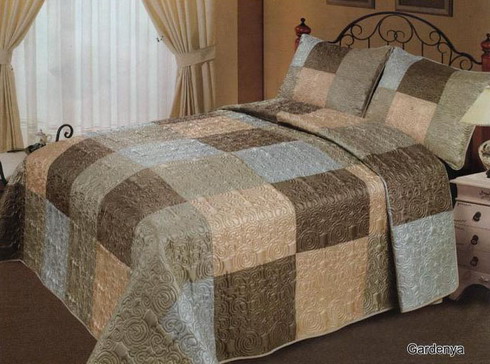Purpose of quilted bedspreads and their characteristics for the right choice

Textiles visually create warmth and comfort in any room. The central place in the bedroom is occupied by a sleeping place, and it is the quilted bedspread on the bed that helps give the interior a harmonious and perfect look. Thanks to a special cloak, you can mask the shortcomings of a berth and smooth out sharp corners.
Content
Features of quilted patterns
The firmware refers to the oldest method of fixing the filler between two layers of fabric. Moreover, the stitches are superimposed on the surface of the bedspread after filling the cover with a special filler. The lines of stitches can be different: parallel, perpendicular, curly. The best option is intersecting seams, since in this case the filler is tightly fixed and its displacement is eliminated when using the bedspread or washing it.
Factory products are sewn with special sewing machines through the entire area. Depending on the materials, ordinary threads (cotton or silk) and a thermal stitch are used, which can be used when sewing products from synthetic fabrics. The process of thermal flashing is carried out using a special device that melts the synthetic fibers pointwise.
The main advantages of quilted bedspreads: products keep their shape well, practically do not wrinkle and have a pleasant aesthetic appearance, durable and practical. Such bedspreads allow you to quickly make a bed and give the bedroom place a neat and well-groomed look.
Criterias of choice
Manufacturers use different materials for sewing bedspreads. Some products can be used as extra blankets. Therefore, when choosing, it is desirable to focus not only on the appearance of the bedspread or the quality of the fabrics. You should also familiarize yourself with the characteristics of fillers.
Material
Textile variety allows you to choose a bedspread that is suitable for cost, quality of the canvas. The following materials can be used for tailoring:
- Natural cotton material makes bedspreads pleasant to the touch, breathable, practical. The most commonly used calico or satin. Coarse calico differs in reasonable price, high durability and wear resistance. Satin is also strong and retains its original appearance for a long time. Thanks to a special double weaving of twisted threads, the satin surface acquires a special delicate silky sheen, which makes the material elegant and gives it an expensive look;
- flax possesses durability, wear resistance, environmental friendliness. This material is quite dense, holds its shape well and is very pleasant to the touch. Linen bedspreads are easy to care for;
- silk has a special delicacy.Thanks to its luxurious and varied design, the bedspread can become the main focus of the room. The undoubted advantages of silk are antibacterial properties, hypoallergenicity. Silk bedspreads do not attract dust. The main disadvantage of textiles is the high price;
- from synthetic materials, acrylic and microfiber are most often used. Acrylic is elastic, retains color for a long time, does not require serious care (just wash in cool water). The main disadvantage is that fibers on the surface can roll. Spools do not form on the microfiber surface and the webs “breathe” perfectly.
It is the beautiful front side that makes the bedspread a true decoration of the bedroom. It is important to take into account the style of the room.
Filler
As an intermediate layer, manufacturers use both natural and synthetic materials:
- wool - this material is attractive due to its lightness, strength, wear resistance, and durability (up to 15 years service life). The coat breathes well and allows the bedspread to air quickly. Camel, sheep, goat wool is used as a filler. Bedspreads made of sheep wool (Australian merino) and goat (cashmere) are especially soft. To create a thin warm layer, apply a gentle undercoat of cashmere mountain goats. Among the disadvantages, the possibility of an allergic reaction to wool and the need to protect the bedspreads from moths can be noted;
- Silk is ideal for summer bedspreads. The filler is based on a high-quality grade of silk - Mulberry. The main advantages: environmental friendliness, durability, hypoallergenicity. The high cost of products, heavy weight (compared with synthetic fillers) can be attributed to the disadvantages of silk;
- plant fibers (cotton, flax, bamboo) are environmentally friendly, but are considered somewhat exotic. These materials are distinguished by hypoallergenicity, comfort, ease of care, low price. Bedspreads with such fillers are suitable for any season. A special advantage of a bamboo filler is antiseptic properties, eliminating the appearance of dust mites, bacteria;
- thanks to synthetic fillers (synthetic winterizer, polyester fiber), bedspreads are light. Depending on the density of the filler (100, 200, 300 g / sq m), the product can cost more and look more magnificent.
Many housewives like to change bedspreads depending on the season. For the warm season, cotton bedspreads with filler from synthetic winterizer, bamboo, silk are suitable. On cold winter nights, things with a woolen layer will perfectly warm.
Lining
For the wrong side of the bedspread, fabrics are selected that are practical and inexpensive:
- calico - cotton fabric, which can include both artificial and natural fibers. For single-sided quilted bedspreads, one-colored fabric is used. Positive qualities: low creasing, hygiene, environmental cleanliness, lightness, durability;
- viscose - artificial fabric (base - wood pulp). Main advantages: lighter than cotton, retains color well, does not accumulate static electricity, high strength, hypoallergenic. For quilted bedspreads, viscose is used, which has undergone additional processing, making the fabric stronger;
- mixed materials consist of natural and synthetic fibers. Thanks to the combined composition, the materials are practical to care for, wear-resistant, pleasant to the touch and have an affordable price.
The main requirement for lining fabrics is that they should not be slippery. Otherwise, a quilted bedspread can constantly move out of bed.
The size
The cover should freely cover the mattress, but not touch the floor. In order not to make a mistake with the purchase, you need to know the exact size of the berth. The best option - on allowances on each side of the mattress lay about 20-25 cm.So, for a bed with parameters of 120x200 cm, a bedspread of 160x200 cm or 160x220 cm is suitable (if there is no headboard at the foot of the bed). The approximate sizes of bedspreads, based on different bed options:
- single - 140x200x220 cm;
- one and a half - 150 / 160x200x220 cm;
- double - 180x200x220 cm or 200x220 cm.
By European standards, quilted bedspreads should hang down to the floor and slightly cover the legs of the bed. Therefore, products are sewn with sizes of 220x240 cm, 230x250cm, or even 270x270 cm.
Some bedspreads can be decorated with frills, frills. As a rule, the quilted part in the products has the size of a berth, and the frill is sewn to its edges. In order not to make a mistake with the choice, it is desirable to sew such bedspreads on order - then it is easier to determine the length of the frill, the area of the quilted base.
How to choose the right color and pattern
Most often, the bedspread plays a large role in the design of the room. In small bedrooms, the bed occupies a large part of the area, and the same colors of textiles and finishes visually “mask” the sleeping place. Therefore, laying a bedspread of a close shade will be a coup for rooms of modest sizes.
So that the interior does not look too monotonous, the quilted product may be slightly highlighted. Light brown textile looks good against a beige background, and turquoise in the blue room. It is the appearance of the thing that can give the atmosphere a cozy and stylish look. A few design tips will help you decide on a quilted bedspread:
- It is important to consider the overall temperature of the room. Orange, yellow or red bedspreads will create a warm comfort in rooms with windows to the north. And the blue, silver shades of textile will bring a cool mood to the bedroom with windows to the south;
- the classic technique is to choose bedspreads and curtains of the same color and pattern. Not everyone will like this conservative decision. However, it is difficult to argue that the interior in this case is harmonious and calm;
- for spacious double beds textiles of dark shades are better suited, but for single beds - light;
- if the cover should become a decoration of the room, then bright products with catchy patterns are chosen. This technique is justified in pastel or neutral rooms. How to choose contrasts is a matter of taste. A blue veil with a silver pattern will create an atmosphere of elegance and tranquility in a light green bedroom. Yellow textile with golden ornaments will look elegant and luxurious in white rooms;
- for the children's bedroom, fabric with bright pictures is selected (uniform arrangement of fruits, geometric shapes). Bedspreads with interesting ethnic ornaments and small patterns will fit into the adult bedroom. A great option for any room - materials in a cage, strip or polka dots.
For the Provencal style bedroom, sandy, pale pink fabrics with a small floral pattern are suitable. For baroque rooms, silk fabrics with a florid golden pattern should be watched. For modern lounges, monophonic quilted quilted fabrics are suitable.
An excellent economical option for lovers of variety is a combined double-sided blanket. In such products, both sides are used as the front. Moreover, the fabric can be in contrasting shades or differ in the quality of the material.
The right choice of bedspreads will help to create an atmosphere of relaxation and peace in the room. Textiles in the interior not only support the style, but also reflect the preferences of the owners, their preferences.
Video



